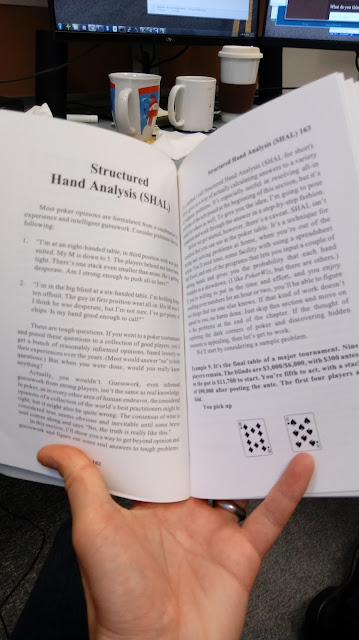Last time in my preamble, I shared that @NateMeyvis of the Thinking Poker Podcast has been offering free copies of his ebook on tournament poker strategy if you send him a copy of your receipt for a >$5 donation to a Houston and/or Irma-related charity.
He just tweeted that the offer is now being extended to Puerto Rico charities as well. Nate has asked for receipts to be sent to the following email address: backing at fastmail dot fm; if you've donated, send a copy of your receipt there to get a copy of his book in return.
Onto the post...
What's funny is that I never actually knew where Ivey had said it. Yesterday, I found out. In Example 3.4.2 on page 73 of our textbook, our author discusses a hand on High Stakes Poker Season 3, in which Brad Booth makes a huge $300,000 bluff against Ivey (and by the way, this is $300,000 of real USD, not tournament chips... Brad Booth has literally wagered a house).
As we discussed the hand in class, I impulsively decided to find it on youtube and project it on our screen, without having actually watched it ahead of time. Here's the footage: that cash DOES look so sweet. The phrase is uttered at 2:26 if you wanna skip ahead to it.
As I didn't watch the clip in advance, I almost lost it when Ivey says it since I had no idea it was coming. I tried to explain to my class why this was so funny to me, but I don't think it really resonated with them. *shrug*
At any rate, the way in which this hand is used as an example is pretty interesting. Ultimately, we want to estimate the probability that Booth is not bluffing. We can turn this into a conditional probability, which we can then estimate using Bayes Rule under some assumptions.
The flop for this hand was 3♦ 7♠ 6♦. Before Booth makes the huge bet, we may estimate the probability that Booth has a great hand for this flop, such as 45, 33, 66 or 77. The author proposes to estimate this probability as 2%.
But then, Booth makes the bet of $300,000. Our author says to suppose that if Booth had a great hand, he would make this bet with 80% probability; if Booth has a terrible hand, he would make this bet with 10% probability; if Booth has anything in between, he would not make this bet (perhaps he would just call, if he had an ok but not great hand).
Acknowledging that these assumptions may be questionable, our author then proceeds to solve this question using Bayes Rule:
- Let \(A\) represent the event that Booth makes this huge bet
- Let \(B_1\) represent the event that Booth has a great hand
- Let \(B_2\) represent the event that Booth has a terrible hand
- Let \(B_3\) represent the event that Booth has any other kind of hand
So, before having the information that Booth makes a huge bet, we estimate a 2% probability that he has a great hand; with these assumptions and the occurrence of the huge bet, we estimate using Bayes Rule that his probability of having a great hand is 44.4%. Again, our author acknowledges that the assumptions here may be questionable, but I think it is still an interesting application of Bayes Rule, and we are free to tweak the assumptions to our liking in order to find our own solution!
The author also makes a connection between Bayes Rule and Structured Hand Analysis, coined by Dan Harrington in Harrington on Hold'em Volume II. Here's me checking it out:
 |
| I was not intentionally trying to mimic Dan Harrington's face. |
and the first couple pages of text:
 |
| Despite my poker inclinations, I'm not sure I ever predicted that I'd be pulling this book out to assist with class prep. |
Harrington and Robertie walk through some math that does resemble Bayes Rule, with the goal of assisting in our decision making. Their setting is where you have multiple opponents who might call with some differing probabilities, and their probabilities of being ahead of you if they do in fact call. They note that they are not proposing that one should ever try and do these calculations in the heat of the moment, but rather that the exercise is useful for examining the situation from different angles, and to give you an overall sense of what you might do in certain circumstances.
Likewise, I don't think Ivey was doing any Bayes Rule calculations at the table in the above footage. But on the other hand, I would argue that in a sense, many of us are making rough approximations using exactly that logic: prior to any action, my opponent has x probability of having a great hand; after they have bet a huge amount, we then change that estimate accordingly. Bayes Rule just gives us a formal way of coming to such an estimate.
Next up: Our 2nd poker night is tonight! I have at least one colleague coming to help out. We also have moved into Expected Value calculations, with which we can now actually talk about the value of each poker decision.
No comments:
What do you think?